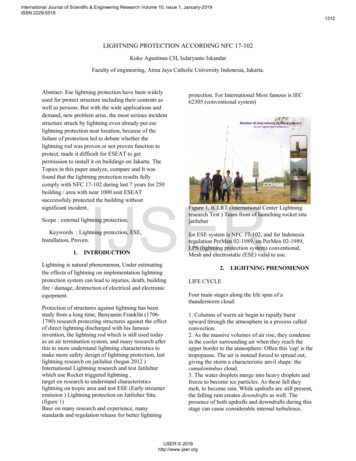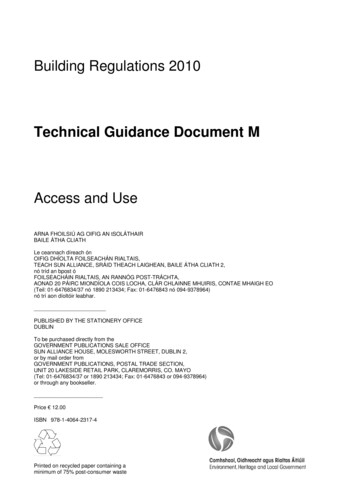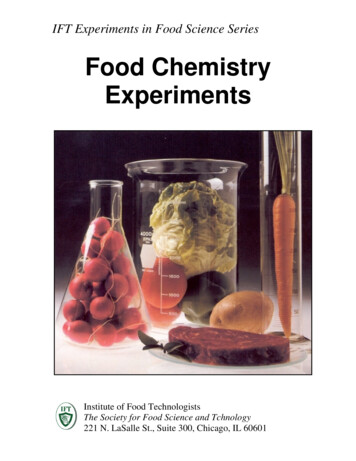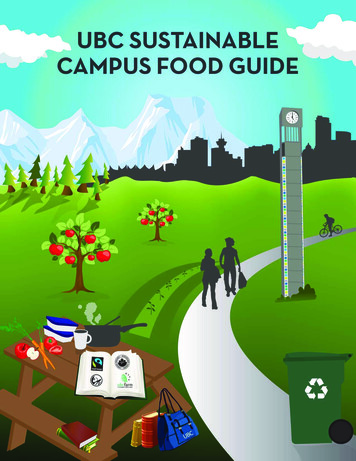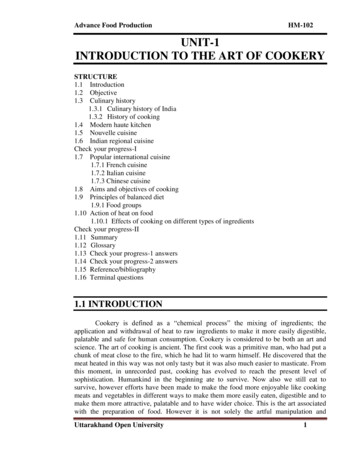
Transcription
Advance Food ProductionHM-102UNIT-1INTRODUCTION TO THE ART OF COOKERYSTRUCTURE1.1 Introduction1.2 Objective1.3 Culinary history1.3.1 Culinary history of India1.3.2 History of cooking1.4 Modern haute kitchen1.5 Nouvelle cuisine1.6 Indian regional cuisineCheck your progress-I1.7 Popular international cuisine1.7.1 French cuisine1.7.2 Italian cuisine1.7.3 Chinese cuisine1.8 Aims and objectives of cooking1.9 Principles of balanced diet1.9.1 Food groups1.10 Action of heat on food1.10.1 Effects of cooking on different types of ingredientsCheck your progress-II1.11 Summary1.12 Glossary1.13 Check your progress-1 answers1.14 Check your progress-2 answers1.15 Reference/bibliography1.16 Terminal questions1.1 INTRODUCTIONCookery is defined as a ―chemical process‖ the mixing of ingredients; theapplication and withdrawal of heat to raw ingredients to make it more easily digestible,palatable and safe for human consumption. Cookery is considered to be both an art andscience. The art of cooking is ancient. The first cook was a primitive man, who had put achunk of meat close to the fire, which he had lit to warm himself. He discovered that themeat heated in this way was not only tasty but it was also much easier to masticate. Fromthis moment, in unrecorded past, cooking has evolved to reach the present level ofsophistication. Humankind in the beginning ate to survive. Now also we still eat tosurvive, however efforts have been made to make the food more enjoyable like cookingmeats and vegetables in different ways to make them more easily eaten, digestible and tomake them more attractive, palatable and to have wider choice. This is the art associatedwith the preparation of food. However it is not solely the artful manipulation andUttarakhand Open University1
Advance Food ProductionHM-102combination of food which results in good tasting products. Nutritional aspects, theeffects of combining various foodstuffs and the use of modern technology can beconsidered the science of cooking. The ―how of cooking‖ can be considered to be the artand the ―why of cooking‖ could be the science. Balancing the art and science must be thegoal of every professional chef.1.2 OBJECTIVEThe objective of this unit is to make the students learn and understand: The evolution of cookery from ancient times to modern age. To understand the most popular cuisines of the world. To gain knowledge about human feeding habit and their well-being.1.3 CULINARY HISTORYDevelopment of the culinary art from the middle ages to modern cookery: Thephrase ―a brief history of culinary preparation‖ is, at best, misleading and, at worst, a baldfaced lie. It is not possible to do justice, in a brief manner, to a subject, which isequivalent to the history of human race. This art and science began more than 300,000years ago when, according to carbon dating, man began to use fire for the preparation offood. There have been very few discoveries or inventions of humanity since fire that havebeen not affected, in some manner, the preparation of food. When was salt first used infood preparation? How did various spices and herbs begin to be used? These and manyother questions concerning the history of food preparation cannot be answered. However,as archaeology has slowly uncovered the ancient civilization around the world, it hasunearthed an increasingly large body of knowledge concerning the world over.When humans first used herbs and spices is not known, but their importance in theancient world is known. The acquisition of these and other foodstuffs was a prime factorin the development of trade routes throughout both the western and eastern hemispheres.Alexander the great brought to Greece spices from the Orient and melons and other fruitsfrom Persia. The trade routes begun by Alexander were later used by the Ptolemy‘s ofEgypt and then by the Roman Empire. Spices and herbs hold a special place in the historyof mankind, having been as eagerly sought as gold, silver and jewels.A less glamorous culinary cousin of spices, grain has always been the key to themight of nations. The treasures of Africa were not simply gold, ivory and jewels of Rome.Africa was more important as the breadbasket of the Empire. The pound of grain, whichwas the right of every citizen of Rome, came from the fertile fields of North Africa. Itwas to protect these shipments of grain that the Roman Empire cleared the MediterraneanSea of pirates and built a system of roads, many parts are still in use today.Historically, the procuring of various foods has always been of great significancefor the Roman Empire it was gram, or the English Empire tea and sugar. Culinarydevelopment initially was tied to developments within an individual country or region;however as each region came in contact with people from other areas, ideas wereUttarakhand Open University2
Advance Food ProductionHM-102exchanged. The result was a traceable progression in the development of food preparationfrom the Egyptians, to the Assyrians, to the Babylonians, to the Greeks, to the Romans,and then directs forerunners of the French kitchen. The French kitchen is the cornerstonefor most historians of the beginning of modern dining in the western world.A pattern of refinement and development of culinary preparation began with theearly Egyptians rulers and continued to the time of Persians. The Greeks refined thetradition of cooking; in fact Greek contribution towards the kitchen was frying pan andfew other things. The citizens of early Rome were admirers of all things Greek made andinvented, but the development of cuisine in the region of Rome is an example of howcuisines have developed in regions all over the world. In the Roman Empire there weretwo levels of culinary development taking place simultaneously. The one most oftendiscussed is that of the ruling elite and their effect on foods. The Romans are to becredited with introducing to the rest of Europe a sense of culinary art.At the age of 14 years a young man name Grillaume of Tirel was a kitchen boywho cooked huge roast in front of the open fire. This young boy was destined to be thefounder of the movement towards the modern French kitchen. Throughout the twentiethcentury the kitchen and menu have been streamlined. Preparations have come to beviewed from the standpoint of nutritional value as well as taste. There is no question thatthe history of culinary preparation has just begun, whether the issue is kitchenorganization, style of service, cuisine and many other issues.1.3.1 CULINARY HISTORY OF INDIACulinary skills and arts of a country are backed by the ―origin‖ which canprecisely be termed as ―Culinary History‖. The origin of each country‘s eating habitshowever have arisen due to the influence from within the country itself or from itsneighbors and some other influence such as climatic conditions, agriculture, religiousaspects etc. Indian cooking has developed–from a purely vegetarian style to today‘smixed style in the process, artistically absorbing the culinary styles of all thesubcontinents, past invaders which include Persians, Greeks, Romans, Mugals, French,Portuguese and the British. Over 5,000 years of recorded history and even before, onegathers from its legends and great epics, India had been invaded by armies, traders andimmigrants from all over the world. Some of the conquerors were the Aryans during thesecond millennium BC, the Greeks, led by Alexander the great in 326 BC, the Mugals inthe 16th Century, the British in the 18th and 19th centuries, but these were interspreadswith more observe and more exotic incursions of Mugals, Sythian, Pasthians, Kushans,Arabs, Turks, Afghans, Portuguese and Dutch and throughout this successions of invadersthere remained pockets of tribal and aboriginal life in the more daunting mountain,country and in the less accessible inland areas.After the independence and partition of India, there was a mass exodus of peopleto Great Britain, Africa and other parts of the world. They took with them eating habitsand spices, and soon Africa started cultivating those spices. The mass migration of Asiansin the 60‘s and 70‘s from east Africa and the sub–continent to Great Britain and otherparts of Europe brought Indian food to the notice of everyone. The sub-continent of Indiaand Pakistan covers about 4 million sq. km. and comprises of many different cultures andUttarakhand Open University3
Advance Food ProductionHM-102regions of which the main being Hindus and Muslims. Equally in the matter of religion anexceedingly important even crucial aspect of Indian life, the country displays a professionof faith, practices and observances as it is the home of Hinduism, and Buddhism and thereligions of the Jains, the Sikhs etc. India as mentioned earlier has a large population ofMuslims and Hindus and contains as well different seats of Christians, one of the oldestsettlements of Jews in the world. Zoroastrians, animists and a number of minor faiths allof these have contributed too in their own manner and ways and attributed to the richtexture of Indian life and living.After all these centuries of foreign contact, India and most of the South East Asiashould still be screened from the western would be such a formidable barrier of fantasy,half-truths, misconceptions and sheer ignorance. Even food, one of the first and mostimmediate contacts a traveler makes with a foreign country remains virtually unexploredand a great and varied cuisine involved from indigenous sources and outside cultureseems to have been reduced in western mind. Travel brings about a maximum contact offood habits of various countries, thereby spreading of spices and delicious.Common culinary skills inherited over the years in each type of:1. Rotis or Indian bread.2. Rice preparation.3. Meat, fish and vegetable with grinding of masalas.4. Indian sweets.1.3.2 HISTORY OF COOKINGThe story of food service is long and interesting, one dating far back to the verybeginning of civilization. Humans began eating the product of their picking such asmushrooms, roots, and fruits. Then, they began to kill or catch animals and eat their flesh.In the same time, they used and then made fire, cooked meat or flesh was first eaten, saidthe legend, by accident when someone dropped his share of meat in the fire anddiscovered it was better. The same happened with the use of salt when someone droppedhis food on a piece of rock where seawater had evaporated. Later, one was introducedagriculture and both cereals and pulses were grown as well as fruit trees introduced by theRomans (peaches, lemon, cherries, apricots, walnuts and plums) from there faraway tripsto Eastern countries. Game meat was the almost unique one eaten until came Geese andPork breeding. The Romans also taught French how to make bread and wine, which hasremained the French staple diet even today. Cumin and vinegar were the first spices andcondiment used. Onion and garlic the main aromatics. Spices came from Asia and werehighly priced. At the period of III century most of the commodities were used. In akitchen, one could find ginger, cloves, chilies, saffron, nutmeg, bay leaf, cumin andturmeric when the spice road was opened.Soups were served – origin of the word ―Soup‖ comes from the Old Frenchlanguage where a ―Soupe‖ was a slice of bread. Other says it comes from Sanskrit wordsSu (well) Pa (feed) giving ―Supa‖ good food. This detail is taken from the very firstFrench Cookery Book (―The Master‖) given by Philip VI and Charles V. GuillammeTirel, Larder Master of the Royal Kitchens was the first known famous Chef de Cuisine(1392) and still today, a restaurant in Paris has his name.Uttarakhand Open University4
Advance Food ProductionHM-102Egypt Birth place of Industry:6000 years ago, human beings wandered into a region along the Nile river, whichis called Egypt today, and found it better suited to their needs, so they settled there. Theclimate was gentle, there was adequate supply of food and water, so people atleast foundis possible to abandon a daily search for essentials to apply their talents to other things.Ancient Egypt was a simple agricultural society. Major crops were wheat and barley thatwas ground into flour for bread. Barely was combined with dates to produce the worldfirst beer. Vegetables like pumpkin, onion, leeks, radishes, watermelons were grown.They raised cattle duck and geese. The Egyptians learned to press oil from olives andsesame seeds and used it regularly in cooking. They used honey with their daily bread,they also made wine.Nearly 4000 years after civilization first took route along the Nile, Egypt was atits peak of prosperity. The entire region was alive with activity, the pyramids were underconstruction, agriculture was producing abundantly, artisans were creating works of greatbeauty, and the industries of the country were manufacturing new products in increasingvolumes. The only problem was one of distribution for the goods produced and in duecourse a new class of merchants of Egypt traveled far and wide on foot or in caravans andthey were compelled to provide themselves with meat and if the merchants did not wantto cook, cooks came along. Travelling in this way becomes complicated and tedious. Sofinally inns appeared along the frequently traveled trade routes. They were crude shelters,but they ensured a degree of safety and comfort without the burden of a huge caravan.In the beginning the inns provided only lodging and the travelers continued tosupply their own food, but in due time this too become the inn keepers service. Much ofthe food we eat today was first discovered in this period and many of the techniques weuse to prepare food are simply modification of system first used by these ancient people.Our modern stove and oven grew from their invention of charcoal burner, which was acylindrical earthenware about 3 in height with 2 metal grills one for the charcoal fire andthe other was the shelf on which the food to be cooked was placed. The bread pans weremade of heavy pottery and their system involved heating empty containers in the stoveuntil they were very hot. At this point the pan was removed from the oven and the doughwas placed in them. Heat stored in the heavy pottery was sufficient to bake the dough andmake it into bread. Egyptians also cooked food over an open charcoal fire. As timepassed, merchants of Egypt expanded their trading and whenever they wanted, 5000 yearsof Egyptian progress was soon transplanted.The custom of food, food preparation drink and dining service was included in theknowledge passed on by the Egyptians approximately 3000 years ago; the center ofcivilization began shifting away from Egypt and came to rest in Greece. It is in this timeand place that the food service industry attained its full measure of professionalism andrespect. In early Greek history preparation of food was simple. The household kept twowomen slaves, to grind and bake bread and cook other dishes. Their talents were limitedand whenever the occasion demanded the host went into the kitchen to prepare food.Later on men were added to the kitchen staff and the man known as Magiero took thetask of preparing bread. The Magiero was a slave but an unusual one for his masterUttarakhand Open University5
Advance Food ProductionHM-102treated him with respect befitting a skilled artisan. In the beginning his duty was ofmaking bread but later it included the overall charge of entire kitchen and other kitchenslaves and all the aspects of food preparation were under his control. He was givenassistance and public acclaim for the feast he prepared. There was a special law, whichpermitted him with exclusive rights to prepare new dish and sell it to public.The Magieros were the first to make cooking a respectable profession and setstandards for its practice. An apprentice system was set up. The novice had to work for 2years under an established Magiero. He had to study from many books the culinary art.The profession grew to one of the greatest respect and the Magieros in Greece becamefree to continue to practice of the culinary profession. They were available to work forpay and some held steady jobs. Most of them worked only when banquets worthy of theirattention was being held. The people of ancient Greece loved to eat and developed manycustoms relating to food and its place in daily life. Three meals were eaten in a day, oneafter getting up, like bread dipped in wine, one in the afternoon which was a simple mealvarying from household to household and the principle meal in the evening consisting oftwo courses, meat with accompaniments and dessert. Kitchens in Greece were wellsupplied with pork, beef, goat, which was prepared by boiling or roasting. Sausages indifferent sizes and shapes were popular. In the beginning the Greeks didn‘t eat in bowland dish but later on they took to it. Sardines with their favourite vegetables like cabbage,lettuce, beans and lentils were eaten regularly, and for dessert, fruit like figs,pomegranates, apples, pears, and grapes were very common. Athens was famous for itsparties. The Greeks liked to socialize and loved to eat in company and at any givenopportunity banquet or party was given. They dined in a semi reclined position and usedthe right arm and hand for eating. Food was eaten from baskets but eventually two sizesof china plates were developed. The meat corner was lined by the only man with a knifein the dining room and it was his duty to cut everybody‘s requirement of meat portionsinto bites sized pieces. Forks were not used but everybody had a spoon like implement tohandle gravy and soup. Main dishes were eaten directly from serving dishes; everyone aterapidly to ensure that they would get the most of their share as possible. The decline ofGreece and ultimate defeat came about in 146 BC when they were conquered by Rome.Meanwhile the Greek merchants and the Greek soldiers spread their customs whereverthey went. The merchants were even able to establish colonies in the name of Greece inthe southern part of Italy and there was a continuos exchange of information. Thus thediscoveries and refinement of Egypt and Greece were soon transplanted to Italy.The Roman Empire: The condition of the Greek colonies in south Italy did not change,people continued their more primitive existence, providing food for themselves, providingshelter and protecting themselves from attack. They realized that defense was animportant consideration and so they built villages on hills. The collection of these villagesgrew to be a great heart of an Empire called Rome by thousands. Soon Romans built upstrong army to defend themselves and any attack of aggression was crushed heavily. Laterthey carried out invasions and the lands owned by the soldiers were annexed and added tothe Empire, thus expanding the Roman Empire.The average Roman citizen was not rich, they were shepherds in farms. Mealswere of fruits, vegetable, porridge, and wine. They ate pork and meat. The number ofUttarakhand Open University6
Advance Food ProductionHM-102meals varied depending upon religious customs, but the pleasure of food and diningplayed an important role in the life of Roman elite‘s who were very rich and could affordthe very best from anywhere in the world. They had staffs able to produce the mostexquisite of dishes. These people were quick to sample foods from other places and werein fact so intent on the discovery of new tastes and sensations that they even setexpeditions to far concerns of the world in search of such things. They found some of theculinary inspiration in Asia Minor they came back with appetite for oriental food. It wasthen that meals began to demand more preparation and expense. The Romans capturedthe Greek colonies in the south and were very impressed with food prepared by Magieroswho they sent to Rome as slaves to work as cooks in the houses of wealthy citizens. Andwhen Rome captured Greece, some more Magieros were sent back to Rome. Thecaptured Magieros accepted their fate and went about teaching the Roman about theartistry of food. In due time they received great acclaim for accomplishments and somewere freed by grateful masters. It was during this year that the duties of the kitchen were1st separated and departmentalized and in 25 AD man called Apicus wrote the first cookbook. The Romans were great meat eaters and birds were highly popular, they loved touse all sorts of condiments, they had no cane or beet sugar so they used grapes syrup andhoney. To meet the new demands made by changed tastes Rome developed asophisticated system of food production, importing and marketing. So they set up acentralized market where all kinds of foodstuffs were sold. The Roman Empire, top heavywith power and luxury and corruption was deteriorating and by a 76 AD it collapsed.All over Europe darkness fell, people returned to a life in small rural villages andled a simple life eating simple food. The 1400 years period of decline and recovery isknown as Dark or Medieval period. The Dark Age was a period of decline and subsequentrecovery for the fortunes of food and dinging customs. Like everything else they sank to avery low point before recovery got underway. The culinary achievements of Greece andRome were stored in written words to be discovered later. The basic social system at thistime was Aendalism where someone who declared themselves as kings and this in turn tobe subdivided and given to lords who in return paid tax and loyalty to the king ownedlarge areas. The lords‘ in turn again assigned lands to tenants or serfs, who tilled the land,grew crops, raised animals. Half or more of the produce went to the Lord who in turngave some to the king and kept some for himself. This way the lords and kings livedcomfortably at the costs of the serfs. This Aendalism produced 2 levels in society witheach one with distinctive habits. The serfs existed on a diet of salt, pork, black beans,turnips and cabbage. While the Lords and kings stuffed themselves with a minimum of 30dishes a meal.Life in the Castle: The great hall was the only place where there was a fire lit. It was inthis place that every member of the castle took the meals, which at times numbered wellover a thousand. The room held tables and everyone sat on benches with no backs, therewas no tablecloth used during most of the Dark ages. Besides the crowd having theirmeals there were number of animals and at times the knights also came in with mounts.Since there was no organization of meal service everybody stood around talking andarguing till his or her turn came to eat.Uttarakhand Open University7
Advance Food ProductionHM-102The courses were heralded by trumpeters and transported to tables in grand style.Food ranged from plain to exotic. There was plenty of pork, game, poultry, beans andpeas served. But other vegetables and fruits were thought to be food fit for pigs. Milk,butter, cheese and honey were available and widely used the refined dining customs ofGreece and Rome was long forgotten in this period and even the royalty ate in a crudeform. The use of plates was discontinued and everyone ate from a round piece of breadcalled trencher. The only table utensil available was a small spoon like implement butstill people preferred to eat with fingers. Food served at that time could be spooned or cutinto bite size pieces stuck together with a gravy or sauce. Trade and travel resulting fromthe crusades gradually broke the grip of Dark Ages and by 1500 things began to moveforward again. Trade with the orient was resumed and introduction of ideas from farplaces did a lot to alter eating habits in Europe. The most popular new item was spice,which was expensive but popular. Cinnamon, ginger saffron, cloves, mace, kesar wereused and for the first 1st time, food was pleasure to the palate. Sugar and almonds werere-introduced. Fruit and vegetables regained popularity and respect. Food became tastierbetween the years 1000 AD and 1400 AD but dining practices still remained crude. Thegreat hall still served as the main dining hall in the castles and was dirty and confused asalways with the discovery of chimney the fireplace made it possible to heat the otherrooms in the castle and the king started dining in private in comfort and quite. Thechimney also made it possible to bring the cooking process indoors which was otherwisedone outdoors on open fire. This improved the food quality.During the late 1400 and early 1500 diners at the royal table were kept amused byan entirely new dimension of culinary artistry. Cooks were instructed to produce food,which was both tasty and entertaining. They devised many dishes to fit this meal whichwas truly unique. In one occasion they produced a huge pastry which was wheeled intothe dining room and when cut open revealed a hollow interior containing 28 musicians.Many such creations were produced when 16th century downed Europe was on its way torecovery, Aendalism withered and died and the old kingdoms gradually evolved asnations. Columbus discovered America. Food become favorite subject and people carriedrecipes and other knowledge of food with them when they traveled from one place toanother. The diet was vastly improved e.g. tomatoes were grown throughout Europe werenever eaten as they were said to be filled with poison. In 1544 a young man who wasforsaken by his lover, decided to commit suicide, ate tomatoes, but didn't die. It wasdelicious. He named it apple of gold. Word of his discovery spread and before longEurope was enjoying tomatoes. Cucumber was first grown in Europe in 1577 aftermerchants returned from Mediterranean with seeds. Pickles were first made and becamepopular. Tea and coffee were discovered and changed breakfast from a meal with wineand beer to sugar. In the 16th century people discovered joy of a beefsteak as cattle wasplenty. Later due to shortage of all meat the church declared a fish day on Friday andSaturday. 17th century brought improvement to food and table service, most importantbeing invention of table fork. It is significant as it altered form of food that could beserved. It is in turn affected kitchen production technique and brought a newprofessionalism to the industry. The old days of sticky much were gone forever anddevelopment in culinary artistry was wide open. One of the culinary arts most widelyexplored during the 17th century was that of the pastry cook. All of the culinary arts werepopular during this time and cooks were treated with respect and were well paid.Uttarakhand Open University8
Advance Food ProductionHM-102Another important development of this period was the re-introduction of thedining plate. In the 18th century Europeans were frequently at war. Emperor Napoleonfound himself in need of an efficient way to feed his armies in the battlefield. So hereasoned that there should be away to preserve food to be carried by his troops whereverthey went instead of forgoing for it. He offered a reward to anyone who could devise sucha system. After many years of experimentation a man Nicholas devised the system calledcanning, where food was packed in sterilized jars and stopped with a cork.THE FRENCH CONTRIBUTIONLe Luire fort excellent de cuisine (the very excellent cookery book) was publishedin 1540 written by P. Pinoux. Catherine of Medicis in 1575 brought in France, the Arts(renaissance) among which were the arts of Cookery. The fork for eating was put onservice by Henry III. After 1600, from Louis VIII, menus became more balanced, morevegetables and less meats (XVII th Century). At this period, champagne was created by amonk, Dom Perignon. Table service has now silver and crystal. Potato is introduced byParmentier and beetroot used to make sugar. C. de Lavarenne Cook of the MarquisD‘uxelles writes ―The French Cook‖ in 1653. S. S. Robert writes 15 years of progress inFrench Cookery in 1680. A sauce still has his name. Vatel is the first victim of Cookery(1671). He was the head cook of the Prince – brother of the king, and committed suicidewhen the fish delivery for the king‘s banquet did not arrive in time. Louis XIV headwaiterwas Marquis de Noritel also known as Louis de Béchamel, creator of this sauce. TheDuke of Richelien, winner of Mahon battle, gave its name to a sauce of his inventionMAHONNAISE or Mayonnaise. The Duke of Mirepoix for its quail recipes.Chocolate was introduced at this date as a beverage as well as coffee and tea. AnItalian Procopio Del Collelli opened the first coffee bar in Paris in 1675, still exists today.Tea was introduced during Renaissance but only used as a drug. The first gastronomiccritic for restaurants was called Grimod de la Reyniere (Almanach des gourmande), whowrote the history of cookery and service from 1789 till 1814. He also wrote the firstRestaurant guide for Parisians. The first take away shops opened at this period. (Corcellet– Potel and Chabot) who also started outdoor catering. Brillat Savarin writes the TastePhysiology and Marie Autonis Careme 1784-1833 his famous Cookery books. Thebeginning of the XIX Century as one can see marks the era of Modern Cookery. Thevictory of Marengo in Italy by Napoleon Bonaparte gave its name to this famous ChickenFricassee made out of the Commodities available on the evening of the battle. Chicken,onions, garlic, tomatoes, eggs, and fresh water prawns (Ecrevisses).Alexander Dunas, also known for ―the three Musketeers‖ wrote his grandDictionary of cookery. Many famous names appear like Auguste Escoffier, the founder ofModern Cookery. Foyot, Maire, creator of the famous Crepe Suzette. La Tour D‘argent,Voyour, on the 1st day of the 20th century, a banquet of 22,000 was served (125 tables of10m each) by 2000 waiters. Later on banquets of 30,000 and 40,000 were organized. Theperiod is between the 2nd world wars, saw the creation of many famous restaurants inparticular Point in Vienne (France) as well as the publication of Michelin guide,classifying a
1.7.2 Italian cuisine 1.7.3 Chinese cuisine 1.8 Aims and objectives of cooking 1.9 Principles of balanced diet 1.9.1 Food groups . Development of the culinary art from the middle ages to modern cookery: The phrase ―a brief history of culinary preparation‖ is, at best, misleading and, at worst, a bald faced lie. .




